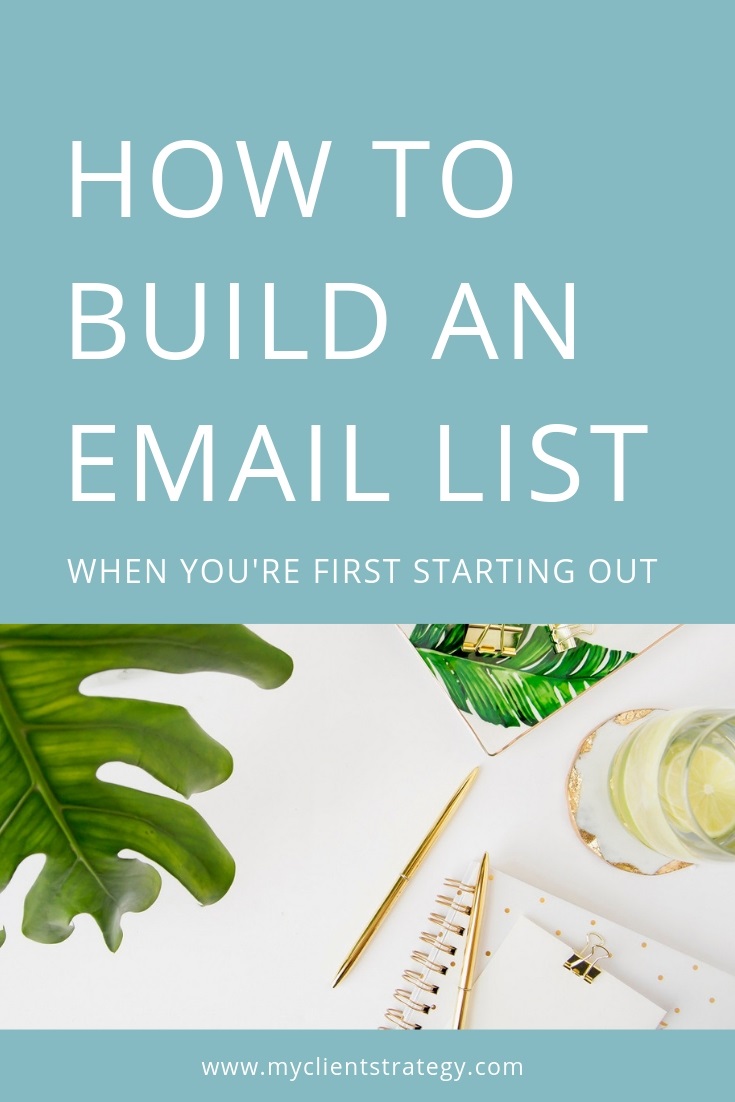How to build an email list when you’re first starting out

It’s essential to build an email list when you’re running a service-based small business.
Your email list is a tangible asset that will grow the value of your business.
Also, when you’re first starting, it’s an effective way to reach your audience in a low-cost manner.
Another great benefit of building an email list is that you’ll have control and ownership over your email address data.
However, if you only have the details of your followers on a social media platform like Facebook or Instagram, then you won’t own the connections or data.
When you don’t own your email address data, you’re marketing costs are likely to be higher.
Over time the cost of reaching followers will increase, as we’ve already seen with the changes that have happened on Facebook.
So, how do you grow an email list for your service-based business?
Here are some simple steps and email list building techniques that you can implement to build a solid foundation for your email marketing strategy:
Step 1. Get clear on your ideal client
There’s no point in having an email list unless it contains the type of clients whom you want to work with.
As such, one of the first tasks you need to undertake is to define what type of clients you want on your email list.
Many small business owners will complete a client avatar or profile of their dream client.
The profile will include their demographic, geographic, and socio-economic information. As well as an outline of the needs and wants of their target market.
RELATED: How to define a target market for your service business
In addition to target market profiling, you’ll also want to conduct some market research on your ideal clients.
One of the best ways to do this is to speak with them or conduct a survey.
Within these conversations and survey questions, you’ll want to ask what problems or pain points they have and what’s important to them.
As well as the social media platforms they use, and how they would go about searching for your type of business.
These insights will significantly assist when it comes to creating an irresistible lead magnet to attract your ideal clients.
Not sure where to start when it comes to marketing your service-based small business? That’s where I can help. Get started by downloading my free 72-point Ultimate Marketing Checklist by clicking the button below:
Step 2. Create an irresistible lead magnet
When creating a downloadable PDF or another type of freebie lead magnet to grow your email list, start by brainstorming topics.
It’s important that these topics link closely to your core service proposition.
For example, if you are a branding photographer, then you’ll want to choose topics that relate to getting brand photos taken.
Alternatively, if you’re an interior designer or stylist, then you’ll want to choose topics that relate to managing a refurbishment or renovation as another example.
By anchoring around these topics, you’ll communicate what it is that you do and how you can serve your ideal clients.
The information contained within the lead magnet will also help you to establish authority in your niche and build trust.
Narrow down your topics to the one you think would help your potential client solve a specific problem.
Then create a lead magnet, which could be in the format of a checklist, cheat sheet, guide, video series, email series, or webinar as examples.
It needs to be able to be delivered and downloaded online in exchange for the potential client’s email address.
One of the most important steps when it comes to your lead magnet is to choose an eye-catching title.
An approach that will help you to build an email list is to include numbers or sales trigger words in the title. Use this free Headline Analyzer tool from CoSchedule to improve your title.
RELATED: 3 Types of Lead Magnets that are Perfect for Service-Based Businesses
Step 3. Set up your email marketing tools
Now that you have a lead magnet ready to attract your ideal clients, it’s time to set up your email marketing tools.
The most important step here is to ensure that your email marketing set up complies with privacy laws. And GDPR as well if you are collecting and storing addresses from Europe.
An email autoresponder is an essential marketing tool that will help you to do this. Also, it will also help you to manage unsubscribes from your list.
When you build an email list, your potential clients must opt-in and agree to be on your email list.
You could do this via a double opt-in (where an email is sent first to confirm that they want to join your email list). Alternatively, you could add a checkbox which users must select to your opt-in form.
Whatever option you choose, be sure to educate yourself on the basics of privacy laws in your region before you start sending emails.
In addition to an email autoresponder, you may also wish to install other technologies and plug-ins to help capture leads.
These technologies include website pop-ups that can be programmed to appear on specific pages or at certain times.
As well as landing page software and tools that will help you to increase sign-up conversions.
RELATED: 30 Marketing tools every service-based business should know about
Step 4. Promote your lead magnet
There are both organic and paid options when it comes to promoting your lead magnet and building your email list.
If you are seeking faster list growth, then paying to advertise on Facebook and Instagram starts from just $5 per day.
Alternatively, if you don’t have a marketing budget, then there are several places on your website to promote your lead magnet and build your email list.
Placing links within blog articles is an effective way to capture email addresses. As is putting links within banners and side-bars on website pages.
Placing links within blog articles is an effective way to capture email addresses. As is putting links within banners and side-bars on website pages. #emailmarketing Share on XMany service-based businesses also create free resources pages on their websites and link these to the menu navigation.
Also, don’t forget to promote your lead magnet via your social media profiles, stories, and pages.
Create social media graphics that promote your lead magnet and encourage followers to join your list. Also, go live on your Instagram stories.
A big part of your online marketing strategy will be to convert your followers to leads on your email list.
Another useful email list building technique is to promote your lead magnet within promotional threads in relevant Facebook groups.
RELATED: How to grow your email list using Facebook
However, don’t just drop a link to your lead magnet and run!
Be sure to spend time in the Facebook groups where your ideal clients are. And add value, so you aren’t viewed as spamming the group.
Also, add a short sentence when you place your link that describes how your lead magnet can help them to encourage more clicks.
Not sure where to start when it comes to marketing your service-based small business? That’s where I can help. Get started by downloading my free 72-point Ultimate Marketing Checklist by clicking the button below:
Step 5. Create amazing core blog or podcast content
Your core content is your blog, podcast, video channel or any other type of evergreen content that you create.
When you create amazing core content, you’re giving your potential clients a reason to stay on your email list.
You see, growing an email list is not just about attracting new potential clients.
It’s also about retaining potential clients on your list so that you see overall email list growth.
Growing an email list is not just about attracting new potential clients. It’s also about retaining potential clients on your list so that you see overall email list growth. #emailmarketing Share on XIt can be very frustrating to see two new people join your list, only to have three other people unsubscribe.
Focus on creating core content that is of value to your ideal client, so it gives them a reason to stay.
A good content marketing strategy will also help you with your email marketing plan.
You’ll never get stuck for ideas on what to email your list when you have good core content.
RELATED: How to create an effective content marketing strategy
Step 6. Maintain your focus
Creating an email list is not something that you can set up and then forget.
Building an email list is a marketing activity that needs attention every single day.
Be sure to include a task or activity every single day that will help you to grow your email list.
As examples, this could include:
- Writing and promoting a new blog post which has a link to your lead magnet;
- Posting a link to your lead magnet in a Facebook group;
- Pinning a new PIN on Pinterest to drive website traffic to your blog;
- Running paid advertising to your lead magnet;
- Adding a post about your lead magnet or content on your social media sites;
- Cold-emailing potential prospects whom you want to build a relationship with.
Also, keep an eye on your email marketing reporting so you can tweak and adjust things to improve your performance.
You’ll need to track how many email addresses you are collecting every day. Be sure to note the marketing activities that work well so that you can do more of them.
When you follow these steps, you’ll be well on your way to growing a high-quality email list for your business.
For more marketing tips on how to grow your service business, download my free 72-point Ultimate Marketing Checklist for Service Businesses. Simply click the button below to download.
Find this blog post helpful? Please don’t forget to PIN to Pinterest or share on Facebook.




